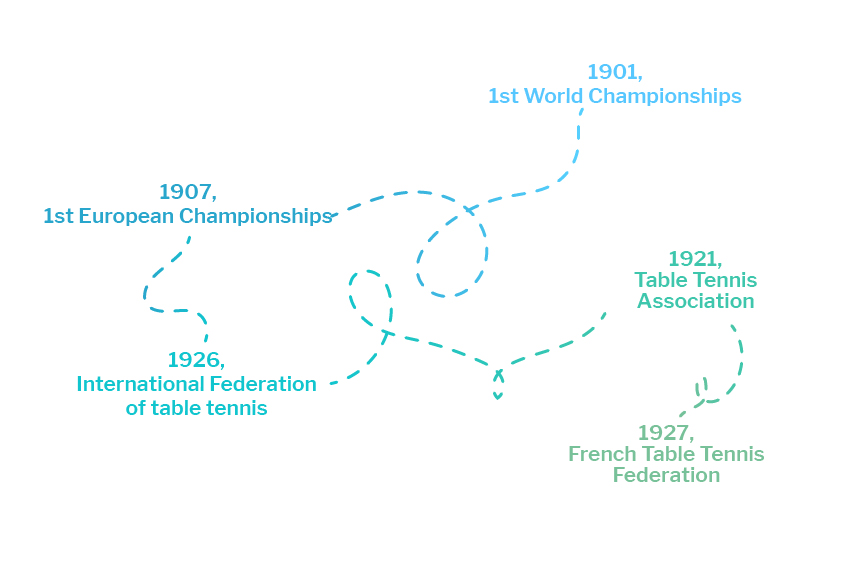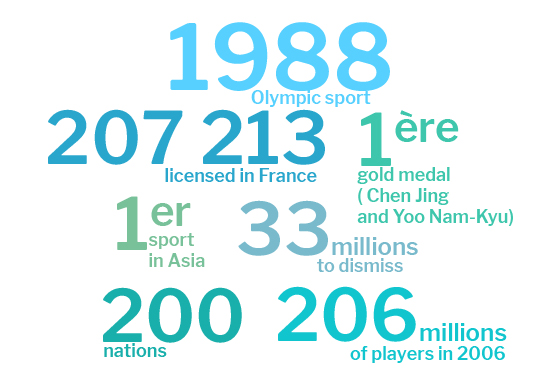Table tennis, a recreational activity and an Olympic sport since 1988, is also known by the term ‘ping-pong’. Though it is excluded from official terminology, this name is very popular today. It notably originates from the onomatopoeic sound of the ball that appeared in the Far East in 1884: ‘ping’ is imitative of the sound of a bat striking a ball and ‘pong’ equates to the sound of the bounce on the table. Does the history of table tennis intrigue you? Settle in comfortably then and let yourself be guided through the beginning of time.
The history of table tennis
The history of table tennis
THE ORIGINS OF TABLE TENNIS

It was in England, in the late 19th century, that table tennis made its appearance. Taking inspiration from lawn tennis, the first players belonged to middle-class Victorian society. The first game would have been played using a champagne cork as a ball, cigar boxes as bats and books for the net. At that point, table tennis was seen as a mere distraction for the wealthy classes. In 1890, Englishman David Foster, attracted by its wide appeal, introduced the first game of tennis on a table. In 1897, the first national championships were organised in Hungary. Following a trip to the United States, in 1901 James Gibb brought back the first celluloid ball, which was a lot lighter than the rubber balls. A year later, in 1902, E.C. Gould, a British enthusiast of the game, introduced the first bats covered in rubber and rubberized pimples. It was game on for the history of table tennis!
THE FIRST TABLE TENNIS TOURNAMENTS
Following on from the success of the first public tournaments at Queen’s Hall in London, it was in 1902 that the first official World Championship took place. The sport enjoyed increased growth and the British Table Tennis Federation was created. The first European Championships were subsequently organised in 1907. Everything stepped up a gear in the 1920s. The Table Tennis Association was created in England in 1921, followed by the International Federation in 1926. The World Championships between the different countries were held in London in 1926 and the French Table Tennis Federation saw the light of day in 1927. The French would participate for the first time in Budapest in 1929. The history of table tennis is coloured by a great many champions, including the Austro-Briton Richard Bergmann, Franco-Polish player Aloizy Ehrilich and the Romanian Angelica Rozeanu.

THE RISE OF TABLE TENNIS IN ASIA
In the 1950s, table tennis became integral to the countries of Asia. The Japanese excelled at the World Team Championships between 1954 and 1959. This domination was bolstered by the introduction of foam, which transformed classic bats. The Japanese have provided several world champions, including the likes of Hiroji Sato, distinguishing themselves with their impressive results in 1956 in Tokyo. The sixties heralded the arrival of Chinese supremacy, punctuated by Zhuand Zedong’s triple world champion titles in 1961, 1963 and 1965. It was during this period that ping-pong diplomacy was developed, which contributed to the improvement in Sino-American relations. In 1977, during the World Championships in Birmingham, the first “Chinese service” was used. The service went from being seen as a mere serve to becoming a strategic element of the game. As such, Asia’s place in the history of table tennis went on to become absolutely critical to the progress of this international sport.
TABLE TENNIS, THE MOST PRACTISED SPORT IN THE WORLD

Table tennis has been an Olympic sport since 1988 in Seoul. The first gold medals were awarded to the female Chinese player Chen Jing and the male Korean player Yoo Nam-kyu. The sport gradually turned professional with the emergence of the Pro Tour in 1996. The practice has remained dominated by the Asian players since 1995, including Wang Liqin, triple world champion and world number 1 for numerous years. Today, table tennis is the most practised sport in Asia. In Europe, table tennis comprises champions like Belgian player Jean-Michel Saive, the German Timo Boll and the Dane Michael Maze. In 2016, Chinese players Ma Long, Fan Zhendong, Xu Xin and Zhang Jike and German player Dimitrij Ovtcharov were leading the world ranking. In 2005, the number of players in the world was estimated to be over 260-million. The International Table Tennis Federation embraces more than 200 nations and 33-million members. Competitions, club tournaments or championships are organised the world over. In June 2016, France boasted 207,213 members. The history of table tennis is today expressed through a constantly evolving infatuation, coloured by the many benefits of regular practice.
TABLE TENNIS EQUIPMENT
Table tennis relies on simple equipment: a table, bats and balls. Indoor tables are favoured for gentle indoor practice. Outdoor tables, which are a lot more solid and durable, are perfect for outdoor games, without risk of damage. Protective Cornilleau covers provide additional protection. For professionals, competition tables provide a level of solidity that can withstand anything. Meantime, foam rubber bats with rubbers provide both precision and control. From beginner, to expert or professional, there are numerous ball models to suit all kinds of games.
The history of table tennis is all the richer for its developments. Today’s most popular sport in the world, it is constantly bringing together players from all walks of life.





